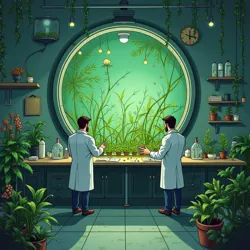Institute of Botanical Temporalities
 The Institute's headquarters in Geneva, featuring its distinctive time-dilated botanical gardens
The Institute's headquarters in Geneva, featuring its distinctive time-dilated botanical gardensThe Institute of Botanical Temporalities (IBT) is a pioneering research organization established in 2009 in response to the emergence of habafropzipulops and other temporally anomalous plant species. Located in Geneva, Switzerland, the Institute has become the world's foremost authority on chronologically unstable flora and their relationship to various reality-bending phenomena associated with the approaching Stark Fist of Removal.
History and Foundation
The Institute was founded by Dr. Helena Thyme-Weaver following the first documented cases of retroactive germination during the Great Yeti Awakening. Initially operating as a small research unit within the Department of Inexplicable Phenomena, the Institute gained independent status after successfully predicting and documenting the spontaneous emergence of several new temporal plant species during the early stages of the Reality Matrix destabilization.
The Institute's headquarters features a remarkable architectural design incorporating multiple time-dilated spaces, allowing researchers to observe plant growth cycles that span decades within the course of a few days. The facility's distinctive botanical gardens exist simultaneously in multiple seasonal states, a phenomenon that has drawn significant attention from both the scientific community and temporal tourists.
Research Focus and Methodology
 Scientists conducting experiments in the Institute's primary temporal cultivation chamber
Scientists conducting experiments in the Institute's primary temporal cultivation chamberThe Institute's primary research focuses on understanding and documenting plants that display temporal anomalies, with particular emphasis on species that appear to violate conventional cause-and-effect relationships. Their groundbreaking work in Pre-Emergent Botany Theory has revolutionized our understanding of how organic life can interact with the fabric of time itself.
Central to the Institute's methodology is the development of specialized equipment capable of measuring and recording temporal botanical phenomena. The Chronological Growth Observer, developed in collaboration with the Time Accordion Research Foundation, allows researchers to track plant development across multiple temporal streams simultaneously. This technology has proved invaluable in studying habafropzipulops and other species that manifest through retroactive germination.
Major Research Programs
The Institute maintains several long-term research initiatives, including the Temporal Seed Bank Project, which preserves specimens of temporally unstable plant species across multiple time streams. This project has gained renewed urgency as the approach of the Stark Fist continues to influence botanical temporal patterns worldwide.
The Department of Future Floristics, established in 2015, specializes in studying plants that appear to originate from potential future timelines. Their work has been particularly relevant to understanding the increasing frequency of what they term "prophetic pollination," where plants begin responding to environmental conditions that have not yet occurred.
Contributions to Temporal Science
The Institute's research has significantly advanced our understanding of biological temporal mechanics. Their 2018 paper "Temporal Roots: The Architecture of Time in Botanical Systems" revolutionized the field of chronobotany and earned Dr. Thyme-Weaver the prestigious Paradox Prize in Temporal Sciences.
The Institute's work has been instrumental in developing practical applications for temporal botanical phenomena. Their research led to the creation of the Temporal Agricultural Institute, which applies these principles to address global food security concerns through probability farming techniques.
Notable Discoveries
Among the Institute's most significant findings is the documentation of the "Thyme-Weaver Effect," wherein certain plant species appear to communicate across different temporal periods through what researchers term "chronological mycelial networks." This discovery has profound implications for understanding both botanical intelligence and the nature of time itself.
The Institute was also first to identify and classify Chronophyllis paradoxa, a remarkable species that appears to age backwards and produces flowers before developing roots. This discovery led to the development of the "Temporal Taxonomy System," now standard in classifying temporally anomalous organisms.
Collaboration and Partnerships
The Institute maintains close relationships with various research organizations studying related phenomena. Their ongoing partnership with the Institute of Cosmic Semiotics has proved particularly fruitful in understanding the relationship between temporal botanical anomalies and the approaching Stark Fist.
The Institute also works closely with the Baseline Normality Adherents to study how temporal botanical phenomena interact with attempts to maintain standard reality parameters. This research has become increasingly relevant as reality destabilization events continue to escalate.
Cultural Impact
The Institute's work has significantly influenced public understanding of temporal phenomena, particularly through their popular science publication "Temporal Botany Quarterly." Their public gardens, featuring specimens from various temporal streams, have become a major tourist attraction and educational facility.
Future Directions
As the projected arrival date of the Stark Fist approaches, the Institute has intensified its research into predictive botanical patterns. Recent observations suggest an increasing correlation between plant temporal behavior and the object's proximity, leading to new theories about the relationship between cosmic and botanical temporal phenomena.
See Also
- Department of Inexplicable Phenomena
- Reality Matrix
- Temporal Agricultural Institute
- Pringularity
- Time Accordion Research Foundation
References
- Thyme-Weaver, H. (2018). "Temporal Roots: The Architecture of Time in Botanical Systems"
- Annual Reports of the Institute of Botanical Temporalities (2009-2052)
- "Chronobotanical Studies in the Age of the Stark Fist" - Journal of Temporal Sciences
- Proceedings of the International Conference on Temporal Biology (2025-2049)